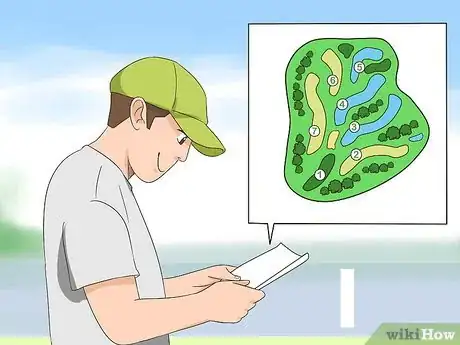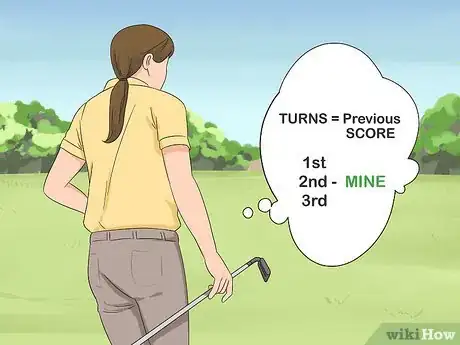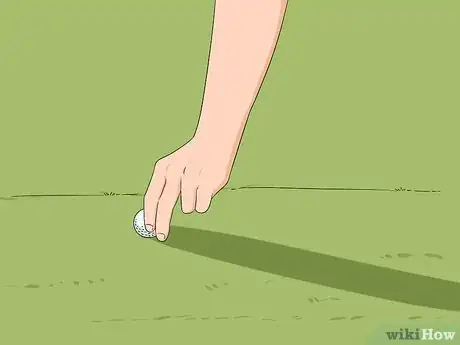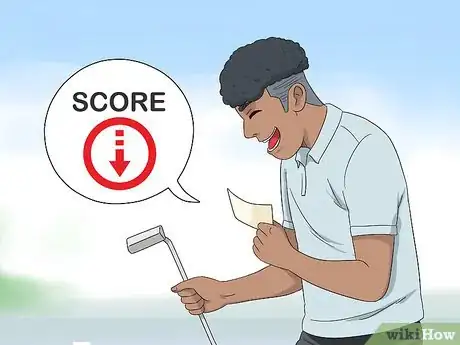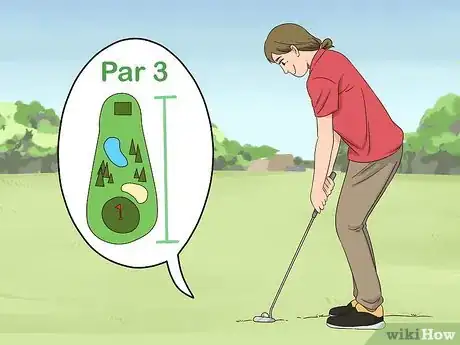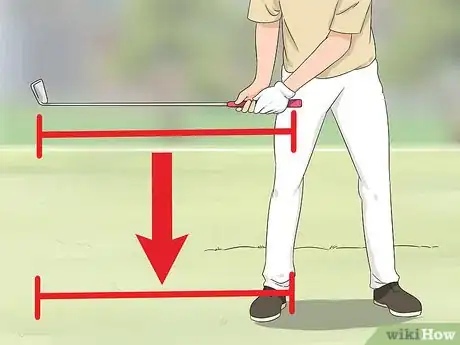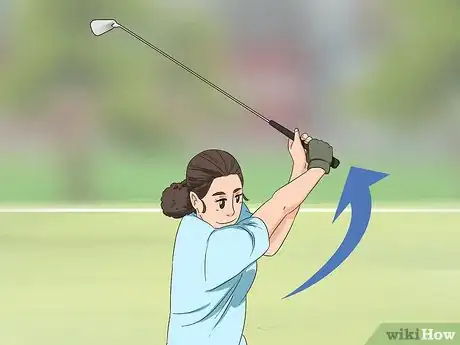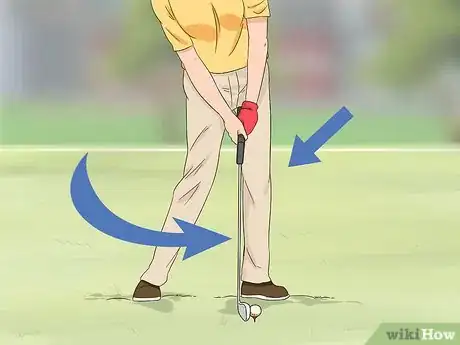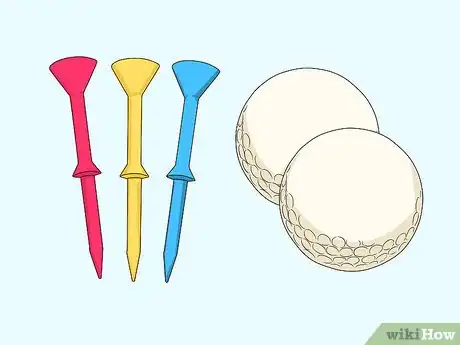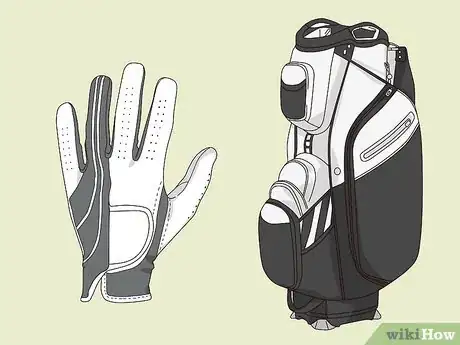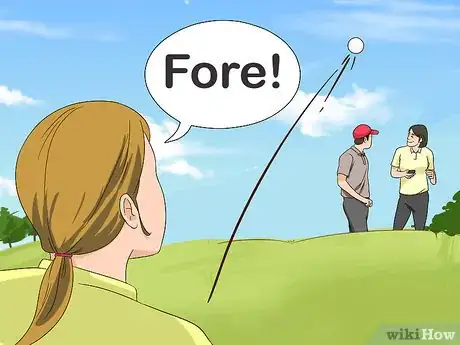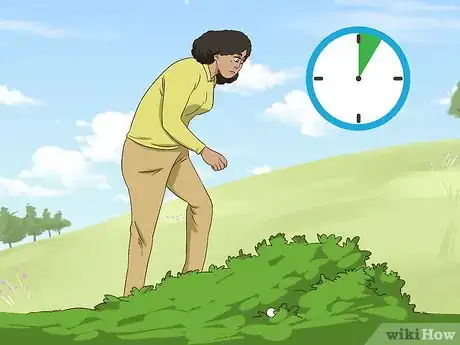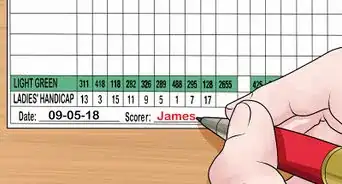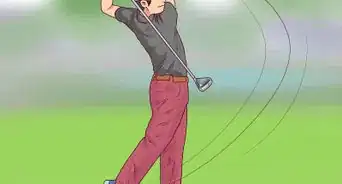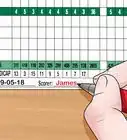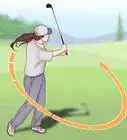This article was co-authored by Michael Metz. Michael Metz is a Golf Instructor and the Director of Instruction at Simi Hills Golf Course. With more than 15 years of experience, Michael is adept at coaching all facets of Golf. Mike uses technology, such as Flightscope, V1 Swing Suite, Blast Motion, and BodiTrak pressure mapping, to provide advanced golf training with quick results.
There are 10 references cited in this article, which can be found at the bottom of the page.
wikiHow marks an article as reader-approved once it receives enough positive feedback. In this case, several readers have written to tell us that this article was helpful to them, earning it our reader-approved status.
This article has been viewed 336,174 times.
Playing golf is a fun, relaxing hobby for many people, and a competitive sport for some others. When learning to play golf, you’ll want to start by learning some basic rules and the technique for swinging a club to hit the ball. It’s also helpful to know how to obtain equipment and to learn some proper golf course etiquette so you can safely have fun with anyone you play with.
Steps
Learning the Basic Rules
-
1Learn the object of the game. In golf, the object of the game is to get your ball from the starting point, or “tee,” to the green and into the hole. The hole is marked by a flag, and you want to get your ball in it with as few shots as possible. “Hole” is not only the physical hole, but also refers to the entire area from the tee to the green, where the physical hole is.[1] According to Golf Teacher Michael Metz, a key skill for beginners is learning to read greens. He suggests, "Imagine [...] the low side is in your palm, the high side is in your fingers. So you always read the palm side, the low side, and then [...] look up. That way you get a truer read [than] if you're reading from the top down. [Also], the lowest spot is wherever the water would pool."
- A standard golf course has 18 holes, or areas with a tee, green, and physical hole marked by a flag. There are smaller courses as well, such as 9-hole courses, which are ideal for beginners.
-
2Play the course by the order of holes. Every golf course is different in terms of how it is structured, and which hole you start and end with. Every hole has a “tee off” area where you start, and a physical hole where you finish. It’s a good idea to carry a course map with you on the course or to go with a group that has at least 1 person who’s familiar with the order of the course.
- Find a course map at the course’s main office, where you check in and can rent gear.
Advertisement -
3Take your turn in your group. To avoid confusion and having everyone hit the ball at once, you should know when your turn is. Usually the person with the best score from the previous hole tees off first, with the next best score going next, and the worst, or highest score, going last.[2]
- After the tee off at each hole, the person who is farthest away from the hole hits first, then the person who is next farthest away, and so on until everyone gets the ball to the hole.
-
4Don’t move your ball on the course. If your ball lands in an unexpected place, which it will when you’re a beginner, it’s against the rules to pick it up and move it. You have to play it where it is, unless it’s blocked by a man-made obstruction, like a yardage marker or a beer can.[3]
- If you’re not sure that something near your ball qualifies as an obstruction, ask a more experienced player.
- If you hit your ball out of bounds or into water, you will have to take a 1 stroke penalty, drop your ball again where you shot it, and try again.
-
5Keep score for each hole. Each hole on a golf course has an ideal number of strokes it should take to get the ball into the physical hole, which is known as the “Par.” Each time you hit the ball counts as a “1” toward your score. Pars range from 3-5, and each hole on a course will be called a “Par 3,” “Par 4,” or “Par 5.”
- Your score on each hole has a nickname relating to the par for that hole. For instance, shooting 2 under par, or getting the ball in the hole in 3 shots on a 5-par hole, is called an “Eagle.” Shooting 1 under par is a “Birdie,” and shooting even with the par is just called “Par.”
- Shooting 1 over par is a “Bogey.” Then 2 over par is a “Double Bogey,” 3 over par is a “Triple Bogey,” and so on.
-
6Win by having the lowest score at the end. When your group reaches the last hole, the person with the lowest overall score is the winner. You can keep track of how you’re doing throughout the game by comparing your score to the pars for each hole. If you’re consistently shooting on par or below par, you’re doing really well.
- In the beginning, you will probably shoot over par, especially on more difficult, 5 par holes. This is totally normal. You will improve with the more practice you have.
-
7Try a Par 3 course when you’re starting out. A Par 3 course means that all the holes on the course are Par 3, so the distances between the tee and the hole are shorter than a standard course, which has a mixture of Par 3, 4, and 5 holes. These courses are ideal for beginners.[4]
- The total par for the course is the number of pars added up from all the holes. This number is typically 72 on a standard golf course, less on a smaller course. A 9 hole, Par 3 course would be a total 27 par course.
Setting Up Your Swing
-
1Stand with your knees and hips slightly bent. Stand with your feet about hip-width apart, with your weight evenly distributed between the centers of your feet, not your toes or heels. Bend your knees slightly and lean forward at your hips so the end of your club is reaching the ground where you’ll be hitting the ball.[5] Golf Teacher Michael Metz suggests standing "with an athletic position—you want to feel as though when you're tilted over at the waist, your hands are hanging a fist or a fist and a half away from your thighs. This promotes proper spine angle."
- When thinking about the right way to stand, imagine how a bowler stands before bringing the ball back to throw it: with their weight even between both feet, and slightly bent forward at the hips.
- The non-dominant side of your body should be facing your target, or the hole. For example, if you are right handed, you will be bringing the club up toward your right and then swinging down and to the left, hitting the ball toward your left.
-
2Bring your club back and parallel to the ground first. When lifting the club, the order from out to in should go clubhead, hands, arms, shoulders, and hips. Your dominant arm should stay close to your side, and as you pass your dominant-sided leg with your hands, your weight should start shifting to that leg.[6]
- When the club is parallel to the ground, it should be faced so the toe, or rounded edge, is up toward the sky.
-
3Bring the club up at a 90 degree angle. Continue moving your weight to your dominant side, and fold your elbows to hinge the club straight up, 90 degrees from your arms, which are about parallel to the ground. Golf Teacher Michael Metz explains it this way: "[for] a true athletic stance, if I was looking sideways, I would see if I could draw a line from someone's balls of their feet, to their knee and to their armpit. And as long as that line is 90 degrees and it touches all three points, that's an athletic stance. So, that's how I would stand for every club, especially irons." You should feel your shoulders in an upward rotation, and more weight on your dominant hip.[7]
- At this point, the toe of your club should be facing back toward the opposite side of the direction you’re swinging.
-
4Turn your shoulders to bring the club all the way up. Twist your shoulders so that your non-dominant shoulder is directly below your chin, and you’re stretching that side’s lateral muscle. This will move your club up and over your head almost 180 degrees, with the club’s weight in your hands and arms and the club head pointing down toward the ground. Golf Teacher Michael Metz notes, "[when] taking your backswing, initiate it with [your] chest and make sure [your] hands are solid at the top of the swing."[8]
- Picture your hands being at an 1 o’clock position – that’s how high they should be from the ground.
- Your dominant hip and ankle, as well as your shoulders, should feel ready to spring downward toward the ball.
Hitting Your Ball
-
1Shift your weight slightly to the other side as you swing the club down. As you bring the club down, your weight should slightly shift toward the direction you’re swinging. Your dominant elbow should pass in front of your dominant hip, but you should keep your body centered with your belt buckle pointed toward the ball.[9]
- Keep your wrists hinged like they were as you start to bring the club down, to avoid throwing the club’s weight from the top.
-
2Straighten your side facing the target as you make contact with the ball. As you make contact with the ball, your hips continue to turn so that your body straightens on the side you’re aiming toward. Your head should remain behind the ball as you make contact, and your dominant wrist should be bent.[10]
- Your weight is now mostly shifted to your non-dominant side, or the side that your target is on.
-
3Extend both your arms fully for the follow-through. Don’t stop your swing after you make contact with the ball. Bring your arms and the club up so that they’re almost parallel to the ground toward your target. Because you’re twisting your hips in the swing, your arms should move almost inside and back toward your body.[11]
- Your dominant knee should kick inward toward the straight knee during the last part of shifting your weight, closing the gap between your legs.
- A proper follow-through stops with the clubhead below the level of your hands, showing you’ve maintained control in your arms and wrists, and the toe of the clubhead is pointing up toward the sky.
Obtaining Equipment
-
1Get the minimum number of clubs you need. You’re allowed to carry up to 14 clubs in your bag, but you only really need a driver, putter, sand wedge, 6-iron, 8-iron, pitching wedge, and a hybrid when starting out. You can rent clubs on the golf course, or find racks of discounted and used clubs at many sporting goods stores.[12]
- If you’ve never played golf before, consider going with someone who will let you use their clubs, renting clubs at the golf course, or going to a driving range to try out different clubs before spending money on your own set.
-
2Obtain tees and balls. Tees are pretty straightforward; they look like a brightly colored wooden or plastic nail that you set your ball on before hitting it. For balls, there is a range of quality and prices to choose from. If you’ve never played before, buy cheap balls that cost around $20 per dozen.[13]
- You will lose balls when you’re first starting out, so it’s best not to spend too much on them right away.
- Some golf courses provide balls for you to play with; find out ahead of time if a golf course does this by calling the course office.
- Golf balls and tees can be purchased at sporting goods stores.
-
3Invest in some golf gloves and a bag. Golf gloves are important because you can start getting blisters on your hands from just a few strokes. They also help you keep a firm grip on your club even if you’re sweating. Go to a sporting goods store to try on gloves and find ones that fit you.[14]
- For a bag, any sturdy bag that carries your clubs, balls, rain gear, water and/or snacks will work. Check out thrift stores, yard sales, or used gear websites online to find a good deal on a golf bag.
Playing With Proper Etiquette
-
1Keep up with your group. While you don’t need to rush your shots or run to your ball, it is important to be ready to hit when it’s your turn. Know when it’s your turn, and limit your practice swings to 1 or 2 before hitting your ball.[15]
- Golf is a social game, so chatting with others in your group is expected, but not when someone is about to take a shot. Too much talking during a shot can distract the person and throw them off.
-
2Yell “Fore!” if there’s a chance your ball will hit someone. This is very important when you’re starting out, because your shots may not go as expected. Don’t wait to yell; the moment you see your ball heading toward a person, yell “Fore!” as loud as you can so they look up and get out of the way of the ball.[16]
- A flying golf ball can seriously injure a person if it hits them. This step is important for safety as well as being common courtesy.
-
3Stay out of the way of shots. When someone is about to take a shot, stand off to the side several yards away and a bit behind them so as not to distract them. Don’t stand or walk between a person taking a shot and their target.[17]
- Stay alert of other players not in your group who are using the course. Occasionally balls from other players will travel onto your hole; don’t touch the ball and allow the person to come get the ball themselves.
-
4Look for a lost ball for only 3 minutes. If you can’t find a ball, spend only about 3 minutes searching for it. After that, take a 1-stroke penalty and do another shot from the location you shot from. To do this shot, stand as close to where you were and “drop” the ball by holding it out at shoulder length and dropping it to the ground.[18]
- If you lose your ball from tee-off, just take the penalty stroke and return to your tee to make the shot again.
Community Q&A
-
QuestionIs playing virtual golf similar to real golf?
 Community AnswerIt is, but is not the same. In some ways, it is a good way to practice without leaving your house, especially for beginners. But, it's a lot better to actually play real golf.
Community AnswerIt is, but is not the same. In some ways, it is a good way to practice without leaving your house, especially for beginners. But, it's a lot better to actually play real golf. -
QuestionHow do I stop topping the ball?
 Community AnswerTo stop topping the ball you must keep your head down for the duration of your swing. Lots of golfers have the tendency to lift their head and body up in the downswing, which causes them to top the ball.
Community AnswerTo stop topping the ball you must keep your head down for the duration of your swing. Lots of golfers have the tendency to lift their head and body up in the downswing, which causes them to top the ball. -
QuestionHow can I improve my swing?
 Community AnswerTake your driver and fill its cover with things that will not damage the club. Put the sock back on, and take a few baseball swings each day. This will help improve your hitting distance and strength.
Community AnswerTake your driver and fill its cover with things that will not damage the club. Put the sock back on, and take a few baseball swings each day. This will help improve your hitting distance and strength.
References
- ↑ http://www.rulesofsport.com/sports/golf.html
- ↑ https://www.golfdigest.com/gallery/golf-beginners-tips
- ↑ https://www.golfdigest.com/gallery/golf-beginners-tips
- ↑ https://www.golfdigest.com/gallery/golf-beginners-tips
- ↑ https://www.golfdigest.com/gallery/todd-anderson-fix-your-swing-fundamentals#2
- ↑ https://www.golfdigest.com/gallery/todd-anderson-fix-your-swing-fundamentals#4
- ↑ https://www.golfdigest.com/gallery/todd-anderson-fix-your-swing-fundamentals#6
- ↑ https://www.golfdigest.com/gallery/todd-anderson-fix-your-swing-fundamentals#8
- ↑ https://www.golfdigest.com/gallery/todd-anderson-fix-your-swing-fundamentals#10
- ↑ https://www.golfdigest.com/gallery/todd-anderson-fix-your-swing-fundamentals#12
- ↑ https://www.golfdigest.com/gallery/todd-anderson-fix-your-swing-fundamentals#14
- ↑ https://www.golfdigest.com/gallery/golf-beginners-tips
- ↑ https://www.golfdigest.com/gallery/golf-beginners-tips
- ↑ https://mistwoodgc.com/media-center/mistwood-blog/176-what-equipment-do-i-really-need-to-play-golf
- ↑ https://www.golfdigest.com/gallery/golf-beginners-tips
- ↑ https://www.golfdigest.com/gallery/golf-beginners-tips
- ↑ https://www.golfdigest.com/gallery/golf-beginners-tips
- ↑ https://www.golfdigest.com/gallery/golf-beginners-tips
About This Article
Golf is a fun hobby and competitive sport where players try to hit their golf ball into different holes along a golf course in as few shots as possible. A standard golf course has 18 holes, although there are shorter 9-hole courses for beginners. Players start the game at the first hole on the course and move through all of the holes in order. At the beginning of each hole is a “tee off” area where players take their first shot for that hole. The smooth, short grass around the hole is called the “putting green,” and the grass between the tee off area and the putting green is called the “fairway.” On a player’s turn, they place their ball on a tee in the ground at the tee off area, choose a club to swing with, and use the club to hit the ball toward the hole. Once everyone in the group has taken their first shot, each player locates their golf ball and takes another turn, starting with the player who is furthest away from the hole. This continues until every player has made their golf ball in the hole, at which point the group moves onto the next hole and repeats the process. Players write down their score after each hole, with each stroke, or swing, they took for that hole counting as 1 point. For example, if it took a player 4 strokes to get their golf ball into the hole, they would score 4 points for that hole. Each hole on a golf course has an ideal number of strokes it should take to get the ball into the hole, called the “par.” A par 3 hole should ideally take 3 strokes to finish, for example. Finishing a hole 2 strokes under par is called an “eagle,” finishing one stroke under par is called a “birdie,” and finishing even with par is just called “par.” Finishing one stroke over par is called a “Bogey,” finishing two strokes over par is called a “Double Bogey,” and so on. The player with the lowest score after finishing all of the holes on the course wins the game. Players are allowed to carry multiple golf clubs with them on the course, and they choose which club they want to use depending on the shot they’re taking. Each type of golf club affects the height and distance the ball travels differently. The main types of golf clubs include woods, which are used to hit the ball long distances with minimal loft and are commonly used to hit the ball off of the tee or when it’s on the fairway; irons, which are used when the ball is less than 200 yards from the putting green and are numbered 1 through 9, with 9 having the most loft and 1 having the least; wedges, which have a high degree of loft and are used to hit the ball a short distance onto the putting green; and putters, which are used to roll the ball on the putting green toward the hole. To swing with a golf club, stand facing the ball with your feet hip-width apart, your knees slightly bent, and the head of the club next to your golf ball. Swing the club back and up behind you so it’s almost 180 degrees, then swing back down and make contact with the ball. Follow through on your swing by fully extending both of your arms. If you want to practice your swing before heading out on the golf course, visit a driving range, where you can practice hitting golf balls with different clubs until you get the hang of it. Keep reading to learn about the equipment you’ll need, like golf gloves and tees!

